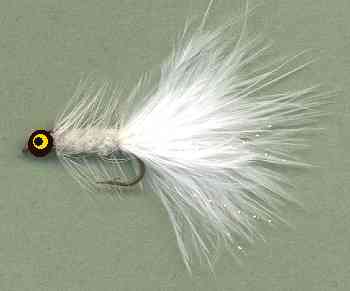The Deepwater White Woolly Bugger Fly
The Woolly Bugger fishing fly pattern has to be one of the most versatile and productive flies around. The marabou tail and in most cases a palmered body suggest succulent small juvenile bait fish, insect larva, tadpoles or leeches that trout, bass and steelhead devour

WOOLLY BUGGER STREAMER FLY PATTERN. Hook size 10 - $US each
The White Deepwater Woolly Bugger Streamer
The deepwater Woolly bugger has a heavy dumbell eye tied to the top of the hook shank and not under the hook shank as normal. This has the effect of inverting the hook so it points upwards and reduces snagging on the bottom. The river or lake bed is where this fly is designed to fish. The weighted head gets it down deep, fast to the right level. When the fish are feeding on the bottom this is the fly to use.
How to fish for trout in the summer heat.
Trout are classified as a cold water species of freshwater fish. Their feeding behaviour is in summer is very much determined by the water temperature. High water temperatures of over 23° C are approaching the limit that a trout will happily tolerate.
Trout go off their food when it gets hot. The last thing on their mind at these temperatures is food. They are no longer searching for food. Instead they are seeking out colder water. In most cases this means going deeper. If they find well oxygenated cooler water with temperatures below 20° C their hunger comes back and they start feeding again.
Brown trout are more sensitive to changes in water temperature than Rainbows. You may find Rainbow trout at mid-depths whilst the Brown trout are near the bottom on a sunny day. This situation seems pretty easy to deal with for any fly fisherman. If you want to catch brown trout in the summer you fish deep.
On the face of it that is correct but, and there is always a but, the amount of oxygen available at the bottom the lake or reservoir is a very important factor on where fish can feed. They still have to breathe. In deeper fisheries the water often stratifies into different layers. Deeper water behaves differently to water near the surface.
The levels of oxygen near the bottom can plummet to fish asphyxiation levels. This is because any organic matter and bacteria use up all the available oxygen leaving nothing for the fish to breath. In these cases the trout avoid this very deep level and swim in a strata above it where they can find enough food to eat and oxygen to breath.
If the fishery is free from lots of organic matter then the oxygen levels at the bottom will remain high and fish will move into these areas during hot weather. How do you find out about the state of the fishery bottom? Ask the owner, fishing lodge manager and other anglers. It will save you time trying to work out at what depth to start fishing. Oh yes the other important information to find out at the same time is the depth of the water. It will save time when preparing your tackle.
I have already covered the topic that trout do not feed in the summer when it is too hot for them. Then why don’t you start fishing at cooler times of the day. At dawn and dusk the water is cooler so the trout have a better appetite and tend to feed during these periods and rest during the daytime. If you are on holiday with your family, get up very early whilst they are still in bed and have a few hours on the water. When the kids have been put to bed in the evening get the fishing rod out again.
Another factor that can affect your fishing results is the clarity of the water. During the summer the water clarity improves. Nutrients that fuel algae blooms will have been used up, so clear water and good eyesight means that the trout will be very aware of the movements of the incautious angler and may spook easily if they see unnatural movement. Fish have an instinctive fear of predation from the air by birds like the fish eagle. They instinctively dart away when they see something move quickly above the water surface.
If the only time you can fish is during the hottest part of the day, apart from fishing deep you might be able to improve your chances of catching a rainbow or a brown trout if you can locate an incoming water supply. This can be in the form of a man-made filter oxygenating outlet pipe, a weir or a feeder stream. Any feature that introduces more dissolved oxygen to the water will be a favoured location for the local fish.

